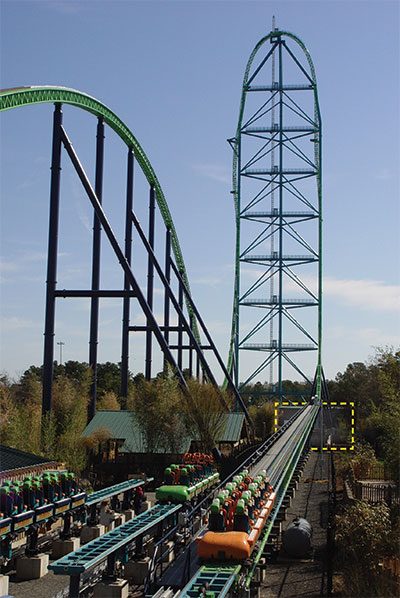
In Russia in the sixteenth or seventeenth century, riders began sliding down wooden ramps on sleds or ice blocks covered with furs.
French soldiers took the idea home, and the first coaster with a car that rolled along a grooved track was built in France, in 1817. It was called the Mountains of Russia.
In 1884, La Marcus Thompson, who had made his fortune in seamless hosiery, built a coaster at Coney Island. The popularity of Thompson’s Gravity Pleasure Switchback Railroad led to a boom in coaster building. But the number of these thrill rides fell from over 2,000 at the start of the Depression to 172 in 1970. Then, tubular steel tracks, pioneered on Disneyland’s Matterhorn ride in 1959, led to a renaissance.
“You could put a loop in it, or you could put a corkscrew in it. Or three corkscrews!” says Michael Reitz, a corporate engineer for Six Flags Great Adventure in Jackson, which happens to be home to Kingda Ka—the tallest (456 feet) and fastest (128 mph) roller coaster in the world.
1. HIGH ENERGY
The hard work is getting the train to the top of the loop, where gravity takes over. Older coasters used manpower or motor-driven chains, Kingda Ka slings the train to the top like a crossbow firing an arrow.
2. There’s A Catch
A long metal bar called the catch car (CC) slides in a groove in the middle of the track. At its front end, the CC has a pocket. A small hook known as the dog hangs beneath the center car of the train and catches in the pocket. The train is ready to launch.
3. Out To Launch
Three steel cables connect the CC to a giant winch in the power station at the far end of the launch area. The two launch cables whip the CC forward, while the third, known as the return cable, pulls it back to its ready position.
4. Pumping Power
Four 500-horsepower pumps on each side of the winch force hydraulic fluid into one chamber of a torpedo-shaped “accumulator.” As the chamber fills, the fluid pushes a piston, pressurizing nitrogen stored in the opposite chamber. When the fluid is released, the compressed nitrogen fires the piston, turning the winch in a furious 3.5-second burst.
5. Gimme A Brake
Two rows of metal fins rise from the track to slow and stop the train. Under the cars, upside-down steel U’s generate a strong magnetic field. When the fins rise into the U’s (never touching them) eddy currents turn the train’s kinetic energy into heat absorbed by the fins, braking the train.
